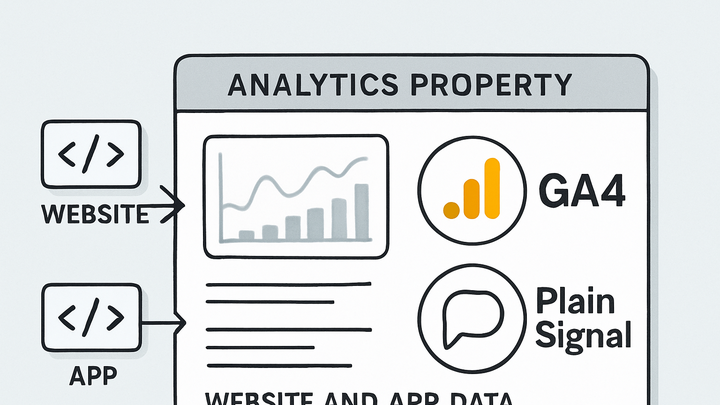Published on 2025-06-22T04:39:16Z
What is a Property in Analytics? Examples in GA4 and PlainSignal
In web and app analytics, a property is a top-level container that holds all the data collected from a specific website or mobile application. It defines the scope of data collection, including events, pageviews, and user interactions. Each property comes with its own configuration settings—like time zone, currency, and data retention—that apply to every data stream within that container. Analytics platforms use unique identifiers for properties (e.g., GA4’s Measurement ID or PlainSignal’s Project ID) so that the correct data flows into the right account. Understanding how properties work is essential to organizing, analyzing, and reporting your digital performance accurately across multiple platforms.
Property
A top-level container in analytics platforms (GA4, PlainSignal) that holds data streams and settings for a website or app.
What is a Property in Analytics?
A property serves as the main container in any analytics tool. It aggregates all the data—from pageviews to custom events—under one roof. Properties make it easy to segment data, apply unified settings, and manage reporting views. Think of a property like a folder: everything you collect from a specific website or app lands inside this folder.
-
Container for tracking data
Holds all interactions, sessions, events, and user data for a specific digital asset.
-
Configuration settings
Defines parameters such as time zone, currency, data retention, and referral exclusions for all incoming data.
-
Unique identifier
Uses a distinct ID—like GA4’s Measurement ID or PlainSignal’s Project ID—to route data correctly into the property.
Property Details in Google Analytics 4
In GA4, each property represents a separate dataset and can include multiple data streams (web, iOS, Android). You configure your property settings in the GA4 interface and use a Measurement ID to initialize tracking in your code.
-
Measurement id
GA4 uses a Measurement ID (formatted as G-XXXXXXX) to identify the property in your tracking code.
-
GA4 tracking snippet
<!-- Global site tag (gtag.js) - Google Analytics --> <script async src="https://www.googletagmanager.com/gtag/js?id=G-XXXXXXX"></script> <script> window.dataLayer = window.dataLayer || []; function gtag(){dataLayer.push(arguments);} gtag('js', new Date()); gtag('config', 'G-XXXXXXX'); </script>
-
-
Data streams
Within a GA4 property, separate data streams let you organize and collect data by platform.
-
Web stream
Collects data from websites using gtag.js or Google Tag Manager.
-
Ios stream
Collects data from iOS apps via the Firebase SDK.
-
Android stream
Collects data from Android apps via the Firebase SDK.
-
Property Details in PlainSignal
PlainSignal is a cookie-free analytics solution that uses a simple tracking snippet. Its property is defined by a domain (data-do) and project ID (data-id), keeping setup lightweight and privacy-friendly.
-
Data domain (data-do)
The data-do attribute restricts data collection to your specified domain for data integrity.
-
Project id (data-id)
The data-id attribute is the unique identifier for your PlainSignal property, directing data into the correct project.
-
Tracking snippet
Include the following snippet to enable PlainSignal tracking on your web pages.
-
Code snippet
<link rel="preconnect" href="//eu.plainsignal.com/" crossorigin /> <script defer data-do="yourwebsitedomain.com" data-id="0GQV1xmtzQQ" data-api="//eu.plainsignal.com" src="//cdn.plainsignal.com/plainsignal-min.js"></script>
-
Best Practices for Managing Properties
Proper property management helps maintain data accuracy and ensures your analytics setup scales with your business needs.
-
Consistent naming
Adopt clear, descriptive names for properties and data streams to simplify team collaboration and reporting.
-
Access control
Assign roles and permissions carefully to prevent unauthorized changes to property configurations.
-
Regular audits
Periodically review property settings, linked accounts, and data streams to ensure alignment with evolving analytics goals.
